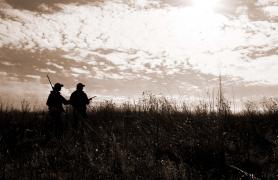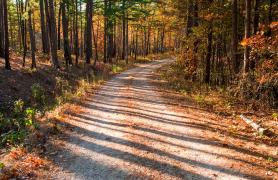Ask any duck or goose hunter — what’s the first thing you do after retrieving a downed bird? More than likely they’ll say they look to see if the bird is banded. This piece of aluminum with a number and contact information on it is the key that unlocks many of nature’s mysteries for hunters and researchers alike.
A Personal Glimpse at the Mysteries of Migration
I recall one fall season when I harvested two banded mallards, and how these bands drew me into a story about all the places these two ducks may have been and why. I was astonished to learn that both mallards were banded in mid-August of that same year near Yorkton, Saskatchewan.
I harvested the first bird, a young mallard, in Saskatchewan over 100 miles northwest of where it was banded. My curiosity was piqued. Why would a recently hatched duck leave one wetland in the fall, fly northwest over countless other wetlands, and then finally decide to stop more than 100 miles away at a wetland that did not look much different than all the others?
I harvested the second mallard, an adult, later that fall in Missouri on a day we were seeing lots of migrating ducks. I couldn’t help but wonder if he had departed earlier that day from one of the same Saskatchewan wetlands I had hunted in October.
These two bands gave me, the waterfowl hunter, a deeper appreciation of all the connections and importance of wetlands from Missouri to Saskatchewan. The information from the millions of bands reported has drawn me, the researcher, into a larger story about population dynamics, habitat, and migration.
Reporting Bands Tells a Larger Story
The U.S. Fish and Wildlife Service (USFWS) uses banding information to determine how many ducks hunters can harvest without causing long-term population declines. Hunters can safely harvest about 11 percent of the mallard population when numbers are high and habitat conditions are good, as they have been the past several years. If duck numbers and habitat conditions decline beyond a certain point, plans are in place to decrease the number of ducks harvested. Researchers predict that a 45-day duck season would reduce mallard harvest rate to about 10 percent, and a 30-day season with a three-mallard (one hen) daily bag limit would result in a harvest rate of about 6 percent.
MDC uses banding information to help identify where to invest in waterfowl habitat conservation. Based on band recoveries in Missouri, we know that over 50 percent of the mallards harvested come from the prairie and parkland regions of Canada. This region also provides critical nesting habitat for nine other duck species and countless other species, including 22 species of land birds, 15 species of shorebirds, and eight species of water birds, all of high conservation priority. MDC contributes about $250,000 each year to conservation work in this important region.
These funds are pooled with contributions from many other states and matched by Ducks Unlimited (DU), USFWS, and the Canadian Wildlife Service to generate over $19 million for waterfowl habitat conservation in Canada. Not a bad return on Missouri’s initial investment of $250,000.
Of course, it’s migration timing that remains the critical question for hunters. When do the birds show up and where do they go once they get here? We know from band data that hunters in north Missouri harvest the most mallards on average during late November and that they harvest as many mallards in early November as they do in late December. In mid-Missouri, the peak harvest of banded mallards occurs about a week later, and more mallards are harvested later in the season than during the beginning of the season. Hunters in southern Missouri harvest slightly more mallards toward the end of the season, but the difference from early in the season to the end of the season is minimal.
Wood Ducks Banded in Missouri
Wood ducks are one of only a few species of waterfowl that nest in Missouri. Because of their secretive nature, it’s nearly impossible to estimate the size of their population based on counts.
We can use banding data to monitor the overall status of wood duck populations, but there is a catch. It requires banding a lot of wood ducks. Each year, states and USFWS work together to band over 30,000 wood ducks. We band over 1,000 in Missouri each year.
Banding wood ducks is a challenge. The basic idea is to lure wood ducks to a bait site and then shoot a rocket net over the top of them before they fly away. MDC Wildlife Biologist Ryan Kelly has banded wood ducks around the state. He and his staff scout a good location and then place corn out each day to entice wood ducks, but that’s not all who shows up. “I’ve seen racoons, deer, opossum, skunks, geese, crows, and pigeons on our bait sites looking for a free meal,” Kelly said. “Once we counted more than 25 racoons on the site at the same time. They can eat a lot of corn!”
Knowing when to take the shot is the biggest challenge. “Wood ducks can take a long time congregating at the edge of the water and it takes a couple of brave souls to start the parade onto land and up to the bait site. Once there, an eagle or hawk flying overhead can spook them back to the water, and you just hope they come back,” Kelly said. “I’ve been burned by being greedy and waiting too long for more birds to get on the bait, or by shooting too soon when I knew I could have caught more by waiting.”
When everything comes together, Kelly and his banding crew may catch and band 100–200 wood ducks with a single shot. The early mornings, battles with mosquitoes, and other challenges faced by wood duck banders has led to discoveries for hunters and managers alike. Imagine the surprise of Ryan Tebo, a Minnesota duck hunter, who harvested a wood duck last fall that was banded six years earlier, shortly after it hatched in southeast Missouri.
“It was the first banded bird I’ve ever taken, so it was an exciting experience to input the band number and see the information associated with that bird,” Tebo said. “It made for an unforgettable hunt and memory for me.”
Based on band recoveries like the one from Tebo, we now know that some wood ducks migrate north during the summer where wetlands may have better food and cover. In early fall, most of the wood ducks that remain in Missouri, as well as those that moved north during summer, migrate as far south as Louisiana.
Canada Geese Banded in Missouri
Canada geese are one of the few other species of waterfowl that nest in Missouri. In contrast to wood ducks, Canada geese are easy to spot and, at times, seem like they are everywhere. Band data provides us important insights on how geese move about in both urban and rural environments. As with ducks, banding data provides important information about survival and the role hunting can play in helping manage this population. To get this information, we band geese throughout Missouri.
Banding geese poses different challenges than banding wood ducks. Rather than using rocket nets, biologists round up geese into a pen and then band them. Erin Shank, an urban wildlife biologist and experienced goose bander, says it’s not as easy as it sounds.
“The first challenge is figuring out the right time in June when the adult geese will likely still be flightless and the goslings are still unable to fly,” Shank said. “Geese go through a period of molt in the summer when they lose their old wing feathers and grow new ones.
“Those older geese must recognize the department triangle on our trucks,” she speculated, with a laugh. “As soon as we arrive, they suddenly straighten up with heads held high. You can tell they are ready to bolt at our first move. In places we haven’t banded, the geese are so much more cooperative. Goose round ups are all about strategy and figuring out how to herd the geese where we want them to go. There’s nothing worse than when a few geese break ranks and then they all start stampeding.”
When everything falls into place, Shank and her crew will catch anywhere from 12–100 geese at a site and will band over 1,000 geese within a two-day period.
Goose banding also provides a unique opportunity for people to get an up-close look at a wild species. Tom McCrackin, past Missouri Ducks Unlimited chairman, has enlisted DU to join forces with Shank to provide kids the opportunity to participate in a goose round up at Six Flags in St. Louis. The kids, along with their parents or grandparents, join the fray and it can be messy. At the end of day, McCrackin presents each child with a green ribbon, otherwise known as the Green Badge of Courage, for their bravery facing these large birds and not letting a little mess spoil the fun.
As with wood ducks, band data has led to discoveries about Missouri’s Canada geese. We often think of them as resident species that never leave Missouri. Banding data shows otherwise. Many geese that are too young to nest or have failed nesting depart Missouri in late May on a “molt migration” to the coast of Hudson Bay in northern Manitoba, Canada. There they will molt old wing feathers and replace them with new.
Once in northern Canada, they are more likely to encounter polar bears and wolves than people. In September, they begin making their way back to Missouri, and most have returned by early October.
The Next Chapters
As a hunter, I’ll keep looking for a band each time I retrieve a bird in hopes of getting a glimpse into their story. As a researcher, I look forward to what we may learn from the larger story as hunters continue to report bands. I encourage you to contribute to the story. If you harvest a banded bird, please report it at reportband.gov.
Missouri Waterfowl Hunters as Citizen Scientists Waterfowl hunters play an important role in helping us understand and manage waterfowl every time they report a band. In the past 10 years, Missouri hunters have reported more than 25,000 bands representing 16 species of ducks, six species of geese, and some hybrids. This information is used to identify which factors have the most influence on population size, to prioritize places for habitat conservation, and to inform hunting regulations (season length, bag limits, and season timing).
If you are ever lucky enough to shoot a banded bird and wonder if it is worth reporting, please know it is time well spent. This information contributes to ensuring sustainable waterfowl populations for the future.
























Also In This Issue


And More...
This Issue's Staff
Associate Editor - Bonnie Chasteen
Staff Writer - Larry Archer
Staff Writer - Heather Feeler
Staff Writer - Kristie Hilgedick
Staff Writer - Joe Jerek
Creative Director - Stephanie Thurber
Art Director - Cliff White
Designer - Les Fortenberry
Designer - Marci Porter
Photographer - Noppadol Paothong
Photographer - David Stonner
Circulation - Laura Scheuler






















